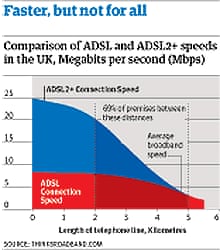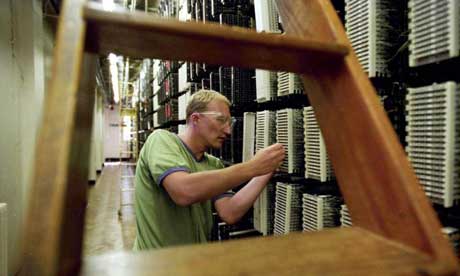From the end of this month, BT will start upgrading its exchange to provide broadband connections running at up to 24 megabits per second - three times the present limit of 8Mbps - thanks to a technology called ADSL2+, which transmits the data signal down the line on a carrier frequency twice as high as the present ADSL2.
But will it mean you'll see an immediate tripling of download speed? And if your ISP can send you more data, will you pay more? There are no clear answers. And then there's the question of whether ISPs which put their own equipment in local exchanges (the process known as local loop unbundling, or LLU) will also be able to offer faster connectivity .
The connection speed issue is a tricky one. The "up to 8Mbps" figure is already one of the most derided in UK broadband; according to Nielsen Online, only 3% of us live close enough to an exchange to get it. That's because broadband speeds fall off with distance from the exchange.

To understand why takes a little physics. A phone line can transmit voice and data simultaneously by sending them at different frequencies. With ADSL2, the data signal is sent on a carrier at about 1.1MHz, far above the audible range. At your telephone socket, the "splitter" then retrieves the data, rather like an FM radio. The further from the exchange, the more of the high frequencies are lost, and the harder to discern the data , effectively lowering the data rate. ADSL2+ doubles the carrier frequency to 2.2MHz. But while that means you can cram more data onto the carrier, the attenuation with distance is greater. So you don't necessarily see a tripling of data speeds everywhere; in fact, at distances above 4.7km, you won't see any difference (see graph). Around 86% of premises are located within a 5km local loop length from their exchange.
Three-year roll-out
The switch to ADSL2+, to be managed by Guy Bradshaw, BT Wholesale's general manager for broadband connectivity, will take several years; even so, says Bradshaw, "at launch, we're looking to provide coverage to about a million people".
It will be up to individual ISPs to decide whether to offer the (potentially) faster speeds. Some already have, through LLU: Oli White, the head of marketing for the ISP Be, points out that his company has offered "up to 24Mbps" since 2005. Virgin, using fibre, is trialling 50Mbps broadband for a roll-out in late 2008.
By summer 2009, BT will have enabled around 850 exchanges serving up to 13 million users (it has around 5,500 UK exchanges) and aims to complete the "vast majority" of the work by 2011.
Point Topic Ltd's Tim Johnson believes there are already 300,000 ADSL2+ users thanks to LLU ISPs like Bulldog and Sky. "With the rollout of 21CN [BT's internet protocol-based backbone "trunk" network for the whole of the country], ADSL2+ will more or less become universal over the next three years," says Johnson.
21CN is key: BT has been remodelling its "trunk" network so that all voice calls, as well as data, can be carried as internet-style packets; in theory, that means higher speeds and fewer problems because the backbone will have internet-style resilience to any single part's failure.
But when will you get ADSL2+? Neil Armstrong, the products and marketing director for the ISP PlusNet, says: "I'm expecting that during the summer we'll be able to add a load of information to our website so that customers can come and see when they'll be able to get those speeds from us." Exchange Status Checker
But there's a fly in the ointment. Andrew Ferguson, of thinkbroadband.com, says BT's ADSL2+ product - called Wholesale Broadband Connect (WBC) - won't be adopted by ISPs immediately. "I am expecting a few providers to launch trials that will last a few weeks or months and larger providers may not launch properly until a large chunk of the country is covered," he says.
Reduced costs
Another key question is cost. "WBC has been designed for flexibility," says BT's Bradshaw. "Its design provides ISPs with the ability to leverage their own network investment more effectively, which may deliver them cost savings." The key element is tiered wholesale pricing with assured rates for "premium" services such as video streaming.
However, it's streaming products - notably including the BBC's iPlayer - that have had ISPs wincing. If just a few hundred people simultaneously watch a programme via iPlayer, it can choke an ISP's network and turn profit into loss. PlusNet's technical team have blogged on the matter, pointing out how in the iPlayer's first month of use, the ISP's streaming costs tripled.
So will PlusNet's ADSL2+ cost the same as its present offering? Armstrong says: "What determines cost is how much the line is used - as customers download more, costs increase. Just moving to ADSL2+ shouldn't automatically increase costs - it's increasing usage that determines cost and whether this results in price rises will depend on each ISP's pricing strategy." At Point Topic, Johnson reckons that ISPs won't change prices.
As to whether the firmware for routers - the software that tells them how to decode a signal - will need upgrading to cope with ADSL2+, Ferguson says: "If it works now on an ADSL line, it will continue to work even if your ISP switches you to the WBC product and you miss the warning notice, or they fail to inform you." Ferguson has written an (ADSL2+ speed estimator tool).
ADSL2+ may be more stable than existing services: Bradshaw says it is built for line speed and stability. As WBC supports premium services, Johnson thinks that ISPs may offer service-level agreements with guaranteed download speeds. "It's actually an opportunity to charge people for things which they couldn't do otherwise," he says. Charges for iPlayer or for video streaming? Don't rule it out.
Growth in video
How will this affect existing ADSL2+ providers? Be's White isn't worried. "We can also differentiate ourselves on the lack of contention on our network and our personal service." For PlusNet, Armstrong sounds positive. "We'll be able to offer our customers higher download speeds, so they can take advantage of the growth in video over the internet." TalkTalk has ADSL2+ on its LLU lines, but currently offers only a capped service at 8Mbps.
The extra bandwidth will be welcomed by content providers. "YouTube, Apple and others are launching higher quality video streaming and downloading," Armstrong says. "A 25-minute high-quality 175MB TV show could be downloaded in just a couple of minutes at 18Mbps."
So is 24Mbps the limit for copper wires? For Stanford University professor John Cioffi, whose work led to the 1993 broadband revolution, the answer is no. ADSL2+ can extend its range using a "dynamic spectrum manager" so speeds reach further along the telephone line. There's more too. "Vectored DSLs can obtain 100Mbps on single line at 1km and higher data rates at shorter distances if they are done very well," says Cioffi. And with reports of Very High Speed DSL (VDSL) offering 250Mbps, there's life in those old wires yet.
